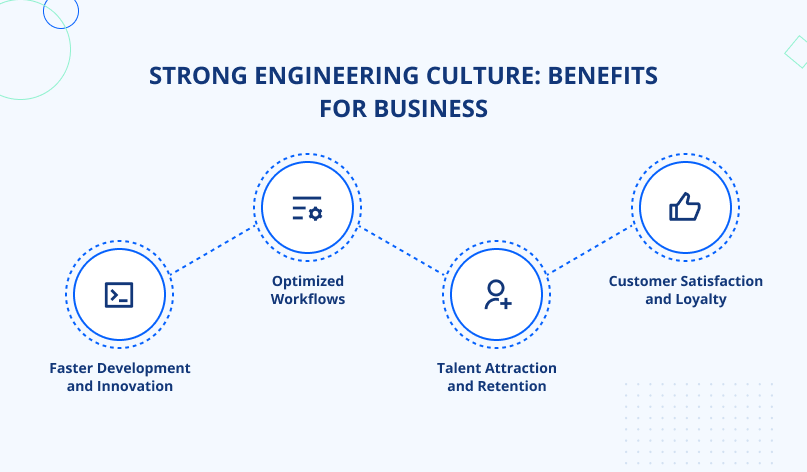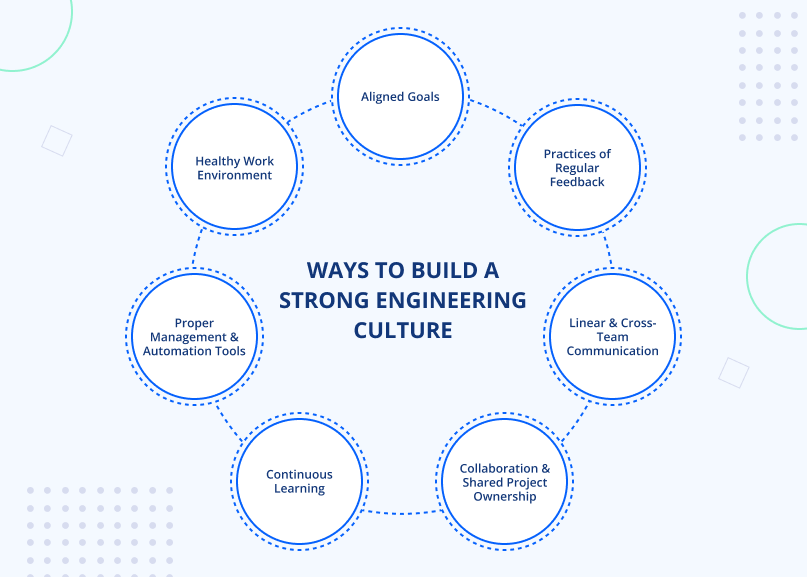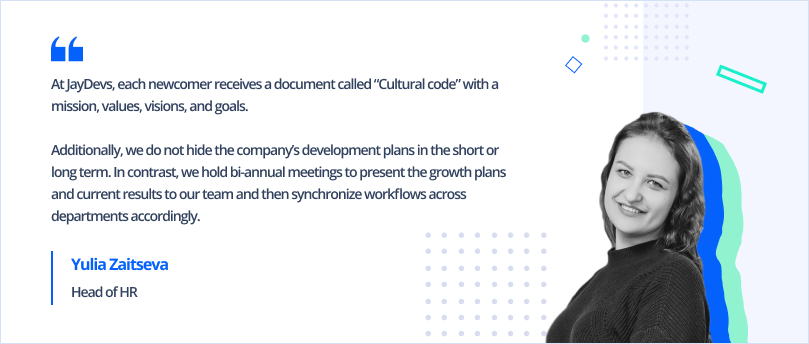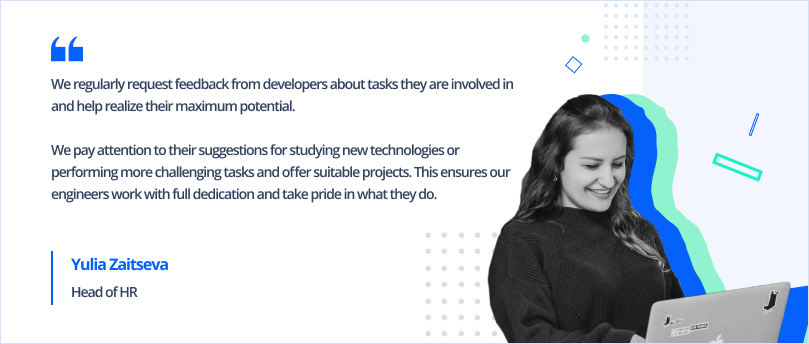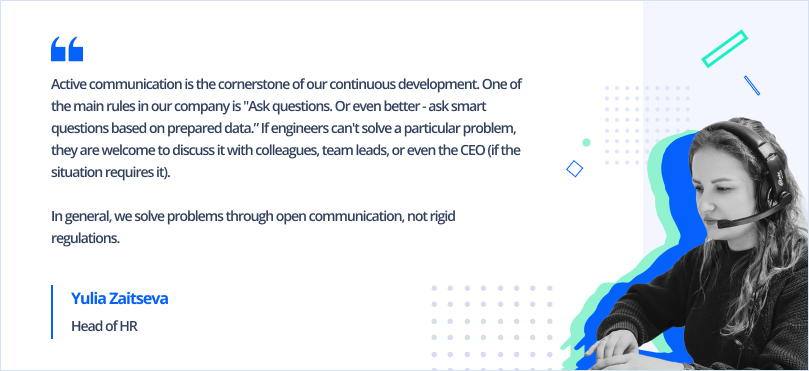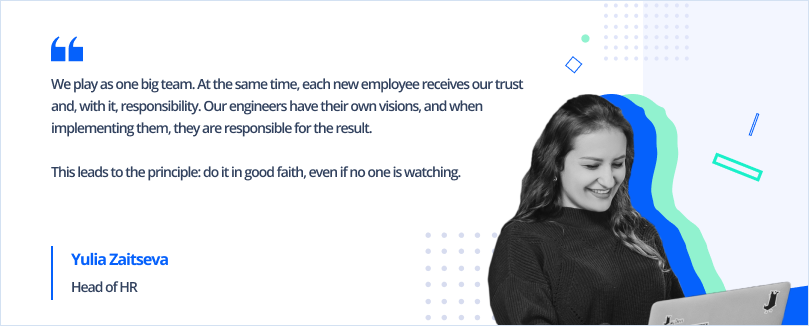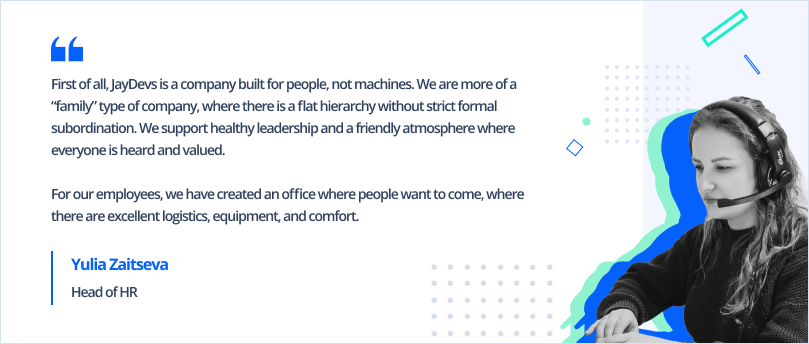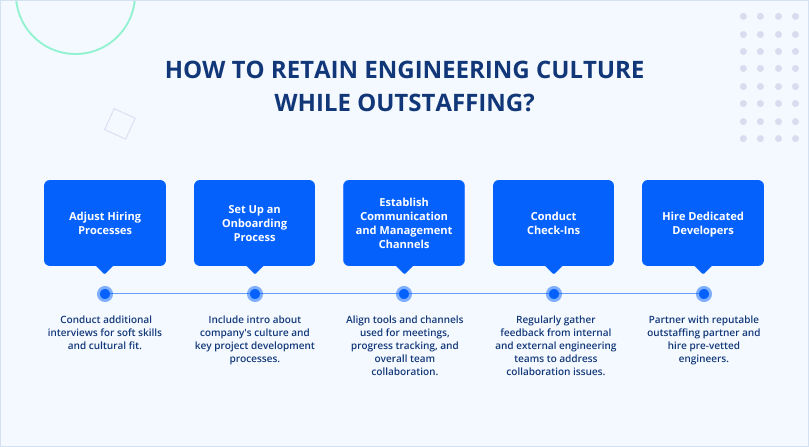Reid Hoffman, LinkedIn co-founder, once said: “No matter how brilliant your mind or strategy, if you’re playing a solo game, you’ll always lose out to a team.” This saying perfectly highlights the importance of a company culture and engineering culture.
Stellar software products and clever strategies, without a doubt, are an advantage. Yet, having a weak or unsteady culture may endanger the company’s success, especially during company scaling.
In this article, we’ll explore the concepts of an engineering culture and insights into fostering it within your organization. We will also discuss techniques for strengthening it when augmenting current teams with external engineers. These principles and ideas may be useful for startup owners, C-level executives, or tech leaders and become a compass for making tech teams stronger than ever.
What is an Engineering Culture?
Software engineering culture serves as the DNA of your organization’s technical team. It represents a set of values, practices, and beliefs that guide how software engineers collaborate to achieve project goals.
Beyond writing code, it’s about creating a healthy environment where seamless collaboration, creativity, initiative, and continuous learning are second nature.
Furthermore, the key tenets of an engineering culture originate from the Agile methodology. During the software development boom in the late 90s, when tech companies were transitioning from “heavyweight” methodologies like Waterfall, Agile emerged as a flexible solution to keep up with the evolving IT landscape. Its principles of adaptability, collaboration, and a focus on customer satisfaction became the heart of projects and formed the bedrock of modern engineering cultures.
In essence, an engineering culture is a shared mindset that fosters teamwork between all team members, including managers.
Impact on Business
According to a report by McKinsey & Company, companies with a strong culture are more likely to have above-average profitability. This could be especially valuable for tech startups on their journey to establishing software development and business processes.
Here are some notable ways in which engineering culture improves the performance of a company:
- Faster Innovation: A great engineering culture encourages experimentation and a little bit of risk-taking. By collaborating, team members can find new ways to solve “old” issues, making the development cycles faster and creating more innovative software products.
- Optimized Processes: A good culture promotes clear areas of responsibility accompanied by close interaction within a team and across different teams. Such an approach streamlines the workflows, thereby eliminating possible blockers and bottlenecks.
- Talent Attraction: Top-notch engineers are naturally drawn to companies with a positive and cohesive culture. About 53% say they prefer companies where developer experience is a priority. Additionally, a healthy culture aids in retaining existing talent, mitigating the costly churn of skilled professionals.
- Customer Satisfaction: When your development team is aligned with customer needs and can respond quickly to customer feedback, it results in higher-quality tech solutions and increased customer loyalty.
In summary, a proper cultural framework is not just a nice bonus but a success strategy. It is a foundation for hiring the right people and forming adaptable teams, which is vital in the modern tech industry.
How to Measure the Level of Engineering Culture in Your Company?
Now that we’ve discussed the importance of an engineering culture, let’s dive into how you can measure its strengths or weaknesses.
Even though culture is somewhat intangible, there are standard mechanisms in place that can support you in evaluating its effectiveness:
- Key Performance Indicators: In most tech companies, each team member has a personalized development plan and KPIs for professional growth. Situations when employees constantly struggle to meet individual performance metrics require an accurate assessment of culture and team management fundamentals.
- Employee Retention: A high employee turnover rate can be a red flag. For the IT industry, this rate spans around 13%, which is pretty high. If this percentage is higher for your in-house engineering talent, it’s time to re-evaluate the basics of your company, with culture at the forefront.
- Employee Satisfaction: Regular employee surveys can be a valuable tool to measure satisfaction levels within engineering teams. For instance, questions about career development opportunities, necessary toolsets, and teamwork can provide honest opinions on what is wrong.
The important point is that business leaders should regularly evaluate at least these three aspects and adjust as needed.
7 Ways to Foster Software Engineering Culture in Your Organization
If the current cultural dynamics don’t align with your expectations or even slow down the company’s progress — you need an actionable plan.
Below, we gathered seven strategies to grow the performance of your engineering team, all aimed at a collaborative and healthy working environment.
1. Common Goals
The first and foremost component of a strong engineering culture involves aligning business goals with the goals of existing and prospective developers.
Think of this as creating a common ground on which your entire company stands. At this point, the aim is not to make people believe in company values and objectives but rather to gather a team of co-thinkers who’ll contribute to their realization.
More importantly, the best practice is to provide regular and transparent updates on company progress and strategic changes to employees. This helps to keep everyone engaged and united by a common purpose.
2. Regular Feedback
Feedback practices are the lifeblood of the professional development of employees and effective working processes.
Firstly, it promotes continuous improvement among employees, helping them refine their skills. Secondly, regular feedback fosters a culture of open communication where each team member feels valued and heard.
Some key feedback practices include:
- Real-time feedback, where managers spot the issues quickly or recognize the achievements of team members.
- Regular feedback from engineers, where they share their impressions about current projects and tasks.
- 360-degree performance reviews that combine peer-to-peer, upward, and downward feedback. It helps to highlight areas of improvement and particular strengths of the entire team.
- Internal Net Promoter Score (NPS) surveys to gauge how likely employees are to recommend your company as a great place to work.
In essence, a good feedback culture works on multiple levels: it circulates from managers to engineers, from peers to each other, and from developers to team leads.
3. Effective Communication
Established communication is vital for the productivity of any software development team. It keeps the team in sync with the progress, enables quick problem-solving, and helps meet deadlines.
For seamless communication, conduct daily or weekly meetings where the entire team shares updates and blockers. Following this, align the tools for these meetings (like Skype or Slack) to facilitate communication among in-house and remote employees as well.
Additionally, make sure there are regular retrospectives at the end of each sprint or project to reflect aspects that went well and those that could be improved.
And finally, foster linear and cross-team communication. Engineers should be free to cooperate directly with designers, analysts, or developers from other teams without always relying on their managers.
4. Collaboration and Shared Ownership
When teammates feel a sense of ownership over their projects and collaborate effectively, the results can be extraordinary.
When each team member takes responsibility for the project’s results, they are ready to go the extra mile to drive its success. At the same time, they don’t feel accountable for it solely but can count on support from colleagues. After all, two heads are better than one, right?
To make such practices a part of your software engineering culture, always establish clear project priorities and encourage engineers to participate in decision-making. For instance, increase team integrity through regular brainstorming sessions, collective idea-sharing, and celebrating achievements as a team.
At the end of the day, these efforts will help to eliminate silos and nurture a collective mindset instead.
5. Continuous Learning
Learning is an integral part of any company culture, where the company management focuses on the professional development of employees. It is a mutual benefit, as engineers not only grow new skills but also foster innovation for company projects.
A quality learning process requires establishing dedicated programs and allocating financial and human resources.
Consider implementing mentorship programs where tech leads share their knowledge with newcomers. You can also complement it with relevant online courses, educational materials, and conferences for more learning opportunities.
As a valuable addition, you can set up internal tech meetups devoted to specific technologies and the latest industry trends.
The key here is to make these processes a regular part of an engineering culture and expand it with new options when feasible.
6. Management Tools
Management tools help automate repetitive tasks for all team members. In this sense, a robust toolset typically covers most project management aspects, ranging from planning and organization to code monitoring and deployment.
Here are some examples of tools widely used in the software development community:
- Project Planning: Apps like Miro and Asana provide visual roadmaps and workflows, simplifying task organization and deadline management.
- Organization: Platforms such as Jira and Monday.com enable structured project tracking, issue management, and collaborative workspaces.
- Monitoring: Software solutions like New Relic and Datadog offer real-time monitoring of applications and infrastructure, ensuring optimal performance.
- Code Deployment: Continuous Integration/Continuous Deployment (CI/CD) tools like Jenkins and Travis CI automate code deployment, thereby reducing errors and speeding up releases.
By investing in management tools that streamline iteration speeds, you significantly boost developers’ productivity and contribute to a strong engineering culture. When the time for scaling comes, your team will already be equipped with an effective toolkit.
7. Work Environment
The work environment, which includes the physical space and the overall atmosphere at the office, is crucial for cultivating a healthy company culture in general.
Employees devote a significant portion of their day to the office, so it’s a company’s priority to offer a comfortable workplace.
This commitment extends to engineers, for whom having the right equipment is the key to a productive working process. Therefore, providing laptops, additional monitors, and reliable software is necessary.
Furthermore, a collaborative office setup encourages engineers to easily share ideas and collaborate. This includes dedicated spaces like conference rooms for one-to-one and group meetings.
Additionally, bonuses like flexible hours, remote work options, insurance, and decent payroll contribute to employee satisfaction and motivation.
In summary, a comfortable and supportive work environment sets the stage for developers to excel. It fosters a strong engineering culture where each team member feels welcomed and actively participates in the company’s success.
How to Save the Internal Engineering Culture when Using IT Staff Augmentation?
As your company grows and evolves, staff augmentation can become a way to handle increased workloads, tap into specialized skills, or accelerate project timelines.
Even though integrating external software engineers can bring valuable expertise to the table, it can also raise concerns about maintaining a strong engineering culture.
When a company has established workflows and collaboration standards — the software development process operates like clockwork. In this context, business owners might be dreaded that involving third-party specialists may cause lower efficiency, quality, and consistency.
However, each concern has a solution. Below, we’ve listed key tactics that could help maintain your culture when augmenting in-house teams.
Adjust Hiring Process
Adapt your hiring criteria to ensure that remote engineers not only possess the necessary tech experience but also align with your company’s unique culture, values, and norms.
Additionally, conduct separate rounds of interviews to assess the soft skills and cultural fit of candidates.
Set Up Onboarding Process
Create a cohesive onboarding program that includes cultural orientation. For example, you can integrate an intro about your team’s values, processes, and expectations as an essential stage.
In this context, ensure that outsourced engineers receive all necessary information on the team structure they’ll be working in, project management processes, key project milestones, and tools.
This step will help to integrate new teammates as smoothly as possible.
Establish Communication and Management Channels
Set unified collaboration tools that enable all team members to communicate and follow the project progress transparently. A classic combination includes Slack for communication, Jira for progress tracking, and email for resolving organizational matters.
More importantly, ensure that newcomers have access to relevant chats, dashboards, or shared documentation while understanding meeting flows within a team.
Such an approach helps all employees remain on the same page, promoting uninterrupted workflows.
Regular Check-Ins and Feedback Loops
Encourage all developers engaged in the project to share their insights on collaboration and suggestions for improvement.
Regular check-ins allow you to swiftly address any potential misalignments within the team, maintaining a harmonious atmosphere.
Additionally, seeking feedback from both groups retains continuous improvement and a culture of openness.
Hire Dedicated Developers
Consider partnering with reputable staff augmentation companies, such as JayDevs, to hire dedicated engineers.
Such companies typically have a pool of vetted and qualified engineers who can integrate into your team for a committed and long-term collaboration.
JayDevs, for instance, boasts over 100 senior and lead IT specialists, from web and mobile developers to DevOps engineers and solution architects. They can provide you not only with proven technical expertise but also bring essential soft skills to the table.

Moreover, our developers focus on becoming a full-fledged part of your team, not people who simply receive tasks. They are always guided by quality and care about the overall result.
Whether you require individual professionals for different projects or a whole dedicated team, with JayDevs, you’re safe to retain cultural continuity and minimize challenges caused by frequent staff changes.
Conclusion
A strong engineering culture is not some luxury reserved for industry giants but a success driver for tech companies of all sizes. Once implemented properly, it improves productivity, enhanced work quality, and overall business excellence.
However, great engineering cultures aren’t built overnight. It’s a journey that requires commitment, dedication, and ongoing attention. By aligning company goals and integrating effective practices for feedback, communication, and continuous learning, you can build a team that helps thrive in the digital age.
To ensure that your engineering culture remains strong while scaling, consider partnering with reputable IT vendors who can offer pre-screened developers.
Luckily, your search might stop here! Just contact JayDevs for more information about possible collaboration models and developers’ availability.




